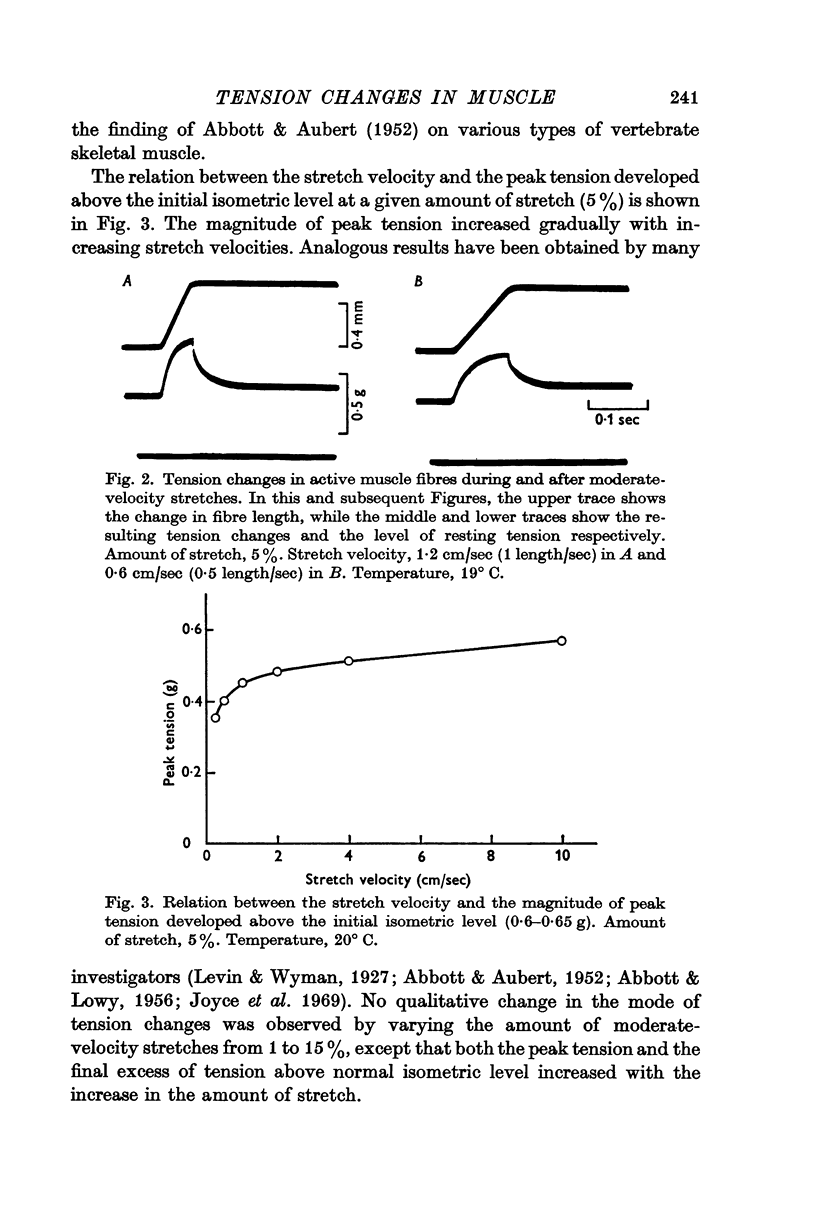Abstract
1. Small fibre bundles from the semitendinosus muscles of the frog were stretched during tetanic stimulation, and the resulting tension changes were studied over a wide range of stretch velocities from 0·1 to 150 cm/sec (0·1-100 length/sec). The experiments were performed within the range of fibre lengths where the resting tension was negligible.
2. With stretch velocities of more than 30 cm/sec (20 length/sec), the tension rose abruptly at first, and then started to fall while the stretch still continued, indicating the `slip' of the contractile component. When the fibres were stretched at 80-150 cm/sec (70-100 length/sec), the tension fell quickly below the initial isometric level at the end of the stretch, and then began to rise again to the initial isometric value.
3. Following stretches of 30-60 cm/sec (20-50 length/sec), the tension showed a delayed transient rise. The delayed rise of tension became more marked as the amount of stretch was increased.
4. In some preparations, oscillatory tension changes were observed following stretches of 50-100 cm/sec (40-70 length/sec).
5. The tension developed above the isometric level during moderate-velocity stretches of less than 15 cm/sec (10 length/sec) increased by lowering temperature, and showed a tendency to decay when the stretch velocity was suddenly reduced during a stretch.
6. These results are discussed in relation to the sliding filament hypothesis, which provides an explanation for the findings of the present work.
Full text
PDF
















Selected References
These references are in PubMed. This may not be the complete list of references from this article.
- ABBOTT B. C., AUBERT X. M. Changes of energy in a muscle during very slow stretches. Proc R Soc Lond B Biol Sci. 1951 Dec 31;139(894):104–117. doi: 10.1098/rspb.1951.0049. [DOI] [PubMed] [Google Scholar]
- ABBOTT B. C., AUBERT X. M., HILL A. V. The absorption of work by a muscle stretched during a single twitch or a short tetanus. Proc R Soc Lond B Biol Sci. 1951 Dec 31;139(894):86–104. doi: 10.1098/rspb.1951.0048. [DOI] [PubMed] [Google Scholar]
- ABBOTT B. C., AUBERT X. M. The force exerted by active striated muscle during and after change of length. J Physiol. 1952 May;117(1):77–86. [PMC free article] [PubMed] [Google Scholar]
- ABBOTT B. C., LOWY J. Stress relaxation in muscle. Proc R Soc Lond B Biol Sci. 1956 Mar 26;146(923):281–288. doi: 10.1098/rspb.1957.0011. [DOI] [PubMed] [Google Scholar]
- Brady A. J. Onset of contractility in cardiac muscle. J Physiol. 1966 Jun;184(3):560–580. doi: 10.1113/jphysiol.1966.sp007931. [DOI] [PMC free article] [PubMed] [Google Scholar]
- Civan M. M., Podolsky R. J. Contraction kinetics of striated muscle fibres following quick changes in load. J Physiol. 1966 Jun;184(3):511–534. doi: 10.1113/jphysiol.1966.sp007929. [DOI] [PMC free article] [PubMed] [Google Scholar]
- Gordon A. M., Huxley A. F., Julian F. J. Tension development in highly stretched vertebrate muscle fibres. J Physiol. 1966 May;184(1):143–169. doi: 10.1113/jphysiol.1966.sp007908. [DOI] [PMC free article] [PubMed] [Google Scholar]
- Gordon A. M., Huxley A. F., Julian F. J. The variation in isometric tension with sarcomere length in vertebrate muscle fibres. J Physiol. 1966 May;184(1):170–192. doi: 10.1113/jphysiol.1966.sp007909. [DOI] [PMC free article] [PubMed] [Google Scholar]
- HUXLEY A. F. Muscle structure and theories of contraction. Prog Biophys Biophys Chem. 1957;7:255–318. [PubMed] [Google Scholar]
- Huxley A. F., Simmons R. M. Proposed mechanism of force generation in striated muscle. Nature. 1971 Oct 22;233(5321):533–538. doi: 10.1038/233533a0. [DOI] [PubMed] [Google Scholar]
- Huxley A. F. The activation of striated muscle and its mechanical response. Proc R Soc Lond B Biol Sci. 1971 Jun 15;178(1050):1–27. doi: 10.1098/rspb.1971.0049. [DOI] [PubMed] [Google Scholar]
- Huxley H. E. The structural basis of muscular contraction. Proc R Soc Lond B Biol Sci. 1971 Jun 29;178(1051):131–149. doi: 10.1098/rspb.1971.0057. [DOI] [PubMed] [Google Scholar]
- Joyce G. C., Rack P. M. Isotonic lengthening and shortening movements of cat soleus muscle. J Physiol. 1969 Oct;204(2):475–491. doi: 10.1113/jphysiol.1969.sp008925. [DOI] [PMC free article] [PubMed] [Google Scholar]
- Joyce G. C., Rack P. M., Westbury D. R. The mechanical properties of cat soleus muscle during controlled lengthening and shortening movements. J Physiol. 1969 Oct;204(2):461–474. doi: 10.1113/jphysiol.1969.sp008924. [DOI] [PMC free article] [PubMed] [Google Scholar]
- Katz B. The relation between force and speed in muscular contraction. J Physiol. 1939 Jun 14;96(1):45–64. doi: 10.1113/jphysiol.1939.sp003756. [DOI] [PMC free article] [PubMed] [Google Scholar]
- Pringle J. W. The contractile mechanism of insect fibrillar muscle. Prog Biophys Mol Biol. 1967;17:1–60. doi: 10.1016/0079-6107(67)90003-x. [DOI] [PubMed] [Google Scholar]
- Rüegg J. C., Steiger G. J., Schädler M. Mechanical activation of the contractile system in skeletal muscle. Pflugers Arch. 1970;319(2):139–145. doi: 10.1007/BF00592492. [DOI] [PubMed] [Google Scholar]
- WOLEDGE R. C. The thermoelastic effect of change of tension in active muscle. J Physiol. 1961 Jan;155:187–208. doi: 10.1113/jphysiol.1961.sp006622. [DOI] [PMC free article] [PubMed] [Google Scholar]


